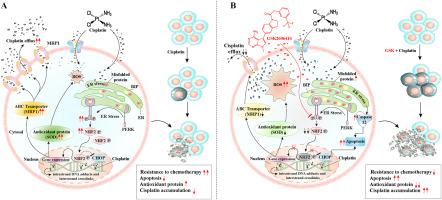Targeting the PERK/NRF2 pathway: Enhancing cisplatin efficacy in resistant ovarian cancer cells via MRP1 and ROS modulation
IF 3.5
3区 医学
Q2 FOOD SCIENCE & TECHNOLOGY
引用次数: 0
Abstract
Overcoming chemotherapy resistance remains a pivotal challenge in ovarian cancer treatment. This study investigates the potential of combining cisplatin with GSK2606414, a PERK inhibitor, to enhance therapeutic efficacy against cisplatin-resistant ovarian cancer cells. cisplatin resistance is driven by the PERK/NRF2 pathway, which activates MRP1 upregulation and antioxidant defenses, thus promoting cell survival. By inhibiting PERK phosphorylation, GSK2606414 disrupts this pathway, downregulating MRP1 and increasing oxidative stress to sensitize cancer cells to cisplatin.
Our findings reveal that the GSK2606414-cisplatin combination significantly reduces cell viability and proliferation, particularly in resistant cell lines, allowing for dose reduction and potentially lower side effects. The combined therapy also amplifies, increasing Caspase-12 and CHOP protein levels during endoplasmic reticulum stress. By targeting the p-PERK/p-NRF2/MRP1 and p-PERK/p-NRF2/SOD pathways, GSK2606414 decreases MRP1 expression and elevates ROS levels, rendering resistant cells more susceptible to chemotherapy. Additionally, this combination boosts intracellular cisplatin accumulation in both cisplatin-sensitive and -resistant ovarian cancer cell lines, reinforcing its cytotoxic impact.
These findings underscore the promise of GSK2606414 and cisplatin co-treatment as a potent strategy to counteract ovarian cancer resistance. This combination could potentially advance therapeutic outcomes and provide a new pharmacological approach to resistant cancers.

靶向PERK/NRF2通路:通过MRP1和ROS调节增强顺铂对耐药卵巢癌细胞的疗效
克服化疗耐药性仍然是卵巢癌治疗的关键挑战。本研究探讨了顺铂联合PERK抑制剂GSK2606414增强对顺铂耐药卵巢癌细胞治疗疗效的潜力。顺铂耐药由PERK/NRF2通路驱动,激活MRP1上调和抗氧化防御,从而促进细胞存活。通过抑制PERK磷酸化,GSK2606414破坏这一途径,下调MRP1并增加氧化应激,使癌细胞对顺铂敏感。我们的研究结果显示,gsk2606414 -顺铂联合用药可显著降低细胞活力和增殖,特别是在耐药细胞系中,从而减少剂量和潜在的更低副作用。在内质网应激过程中,联合治疗也会增加Caspase-12和CHOP蛋白水平。GSK2606414通过靶向p-PERK/p-NRF2/MRP1和p-PERK/p-NRF2/SOD通路,降低MRP1表达,提高ROS水平,使耐药细胞对化疗更敏感。此外,这种组合促进顺铂敏感和耐药卵巢癌细胞系的细胞内顺铂积累,加强其细胞毒性作用。这些发现强调了GSK2606414和顺铂联合治疗作为对抗卵巢癌耐药的有效策略的前景。这种结合可能会提高治疗效果,并为耐药癌症提供一种新的药理学方法。
本文章由计算机程序翻译,如有差异,请以英文原文为准。
求助全文
约1分钟内获得全文
求助全文
来源期刊

Food and Chemical Toxicology
工程技术-毒理学
CiteScore
10.90
自引率
4.70%
发文量
651
审稿时长
31 days
期刊介绍:
Food and Chemical Toxicology (FCT), an internationally renowned journal, that publishes original research articles and reviews on toxic effects, in animals and humans, of natural or synthetic chemicals occurring in the human environment with particular emphasis on food, drugs, and chemicals, including agricultural and industrial safety, and consumer product safety. Areas such as safety evaluation of novel foods and ingredients, biotechnologically-derived products, and nanomaterials are included in the scope of the journal. FCT also encourages submission of papers on inter-relationships between nutrition and toxicology and on in vitro techniques, particularly those fostering the 3 Rs.
The principal aim of the journal is to publish high impact, scholarly work and to serve as a multidisciplinary forum for research in toxicology. Papers submitted will be judged on the basis of scientific originality and contribution to the field, quality and subject matter. Studies should address at least one of the following:
-Adverse physiological/biochemical, or pathological changes induced by specific defined substances
-New techniques for assessing potential toxicity, including molecular biology
-Mechanisms underlying toxic phenomena
-Toxicological examinations of specific chemicals or consumer products, both those showing adverse effects and those demonstrating safety, that meet current standards of scientific acceptability.
Authors must clearly and briefly identify what novel toxic effect (s) or toxic mechanism (s) of the chemical are being reported and what their significance is in the abstract. Furthermore, sufficient doses should be included in order to provide information on NOAEL/LOAEL values.
 求助内容:
求助内容: 应助结果提醒方式:
应助结果提醒方式:


